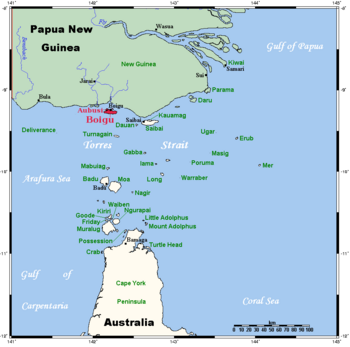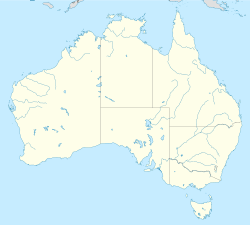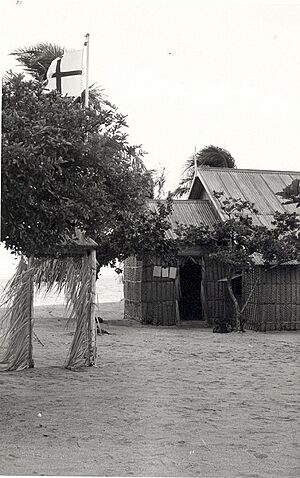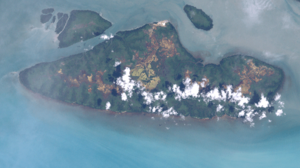Boigu Island (Queensland) facts for kids

Boigu within the Torres Strait Islands
|
|
|
Boigu Island (Queensland, Australia)
|
|
| Geography | |
|---|---|
| Location | Torres Strait |
| Coordinates | 9°15′34″S 142°12′46″E / 9.2594°S 142.2127°E |
| Archipelago | Torres Strait Islands |
| Area | 89.6 km2 (34.6 sq mi) |
| Length | 18.12 km (11.259 mi) |
| Width | 5.05 km (3.138 mi) |
| Highest elevation | 18 m (59 ft) |
| Highest point | unnamed |
| Administration | |
|
Australia
|
|
| State | Queensland |
| LGA | Torres Strait Island Region |
| Island Region | Top Western |
| Largest settlement | Boigu |
| Demographics | |
| Population | 199 (2021) |
| Pop. density | 3.0 /km2 (7.8 /sq mi) |
| Ethnic groups | Torres Strait Islanders |
| Boigu Island Queensland |
|||||||||||||||
|---|---|---|---|---|---|---|---|---|---|---|---|---|---|---|---|
| Population | 199 (2021 census) | ||||||||||||||
| • Density | 3.002/km2 (7.78/sq mi) | ||||||||||||||
| Area | 66.3 km2 (25.6 sq mi) | ||||||||||||||
| Time zone | AEST (UTC+10:00) | ||||||||||||||
| LGA(s) | Torres Strait Island Region | ||||||||||||||
| State electorate(s) | Cook | ||||||||||||||
| Federal Division(s) | Leichhardt | ||||||||||||||
|
|||||||||||||||
Boigu Island (also called Malu Kiyay or Malu Kiwai) is the most northern inhabited island in Queensland and all of Australia. It is part of the Top Western group of the Torres Strait Islands. These islands are located in the Torres Strait, which separates Australia's Cape York Peninsula from the island of New Guinea. The mainland of Papua New Guinea is very close, only about 6 kilometers (3.7 miles) from Boigu.
Boigu Island covers an area of about 89.6 square kilometers (34.6 square miles). The town and local area on the island are also known as Boigu Island. Most people living here are Indigenous Torres Strait Islanders. In the 2021 census, the island's population was 199 people. Of these, 189 people, or 95% of the population, identified as Indigenous Australians. Boigu is the largest and only inhabited island in the Talbot Islands group.
Contents
Island Languages and Connections
The people of Boigu Island speak a language called Kalau Kawau Ya. This language is also spoken on the nearby islands of Dauan and Saibai. People from these three islands see themselves as one community.
Kala Kawaw Ya (also known as Kalaw Kawaw, or KKY) is one of the important languages of the Torres Strait. It is the traditional language of the Top Western islands in the Torres Strait Island Region.
Boigu Island Geography
Boigu Island is about 18 kilometers (11 miles) long and is quite flat. It was formed over a long time by alluvial sediments. These are tiny bits of dirt and sand carried by rivers from nearby New Guinea and dropped into the Strait. These sediments built up on an old coral platform, eventually creating the island.
The island is separated from the mainland of Papua New Guinea by a stretch of water. At its narrowest point, this water is about 6 kilometers (3.7 miles) wide. Boigu Island is also the closest Australian land to the country of Indonesia. It is only about 123 kilometers (76 miles) east-southeast of the southern tip of the Indonesia–Papua New Guinea border.
The main village of Boigu is located at the northern end of the island. It is the northernmost settlement in Australia. However, the northernmost piece of land in Australia is an uninhabited place called Bramble Cay, which is about 173 kilometers (107 miles) to the east.
Most of Boigu Island often experiences large floods. Because of this, the main community area has been built on the highest ground available.
Nearby Islands
There are several smaller islands close to Boigu, including:
- Aubussi Island, also known as Awbuz
- Moegina Kawa
- Sapural Kawa
- Aymermud
- Moimi Island, also known as Moeyim
The Boigu Island Airport is located on the south-western edge of the village.
Boigu Island History
Missionaries from the London Missionary Society visited Boigu sometime after they set up a mission on nearby Saibai Island in 1871.
From the 1870s to around 1910, the people of Boigu, Dauan, and Saibai faced challenges from fierce warriors from what is now southeast South Papua. These warriors were known for taking heads. Sir William MacGregor, who was in charge of British New Guinea in 1886, thought that the population was almost gone because of these attacks. However, he didn't realize that most people had moved to Saibai and Dauan to stay safe with their families.
In 2004, figures from the Torres Strait Regional Authority (TSRA) showed that about 340 people lived on the island.
The Malu Kiwai State School first opened on January 29, 1985. In 2007, it joined with 16 other schools in the Torres Strait Islands. It became the Malu Kiwai Campus of Tagai State College, which has its main campus on Thursday Island.
In the 2016 census, 271 people lived on Boigu Island. Of these, 231 identified as Indigenous Australians. By the 2021 census, the population was 199 people, with 189 identifying as Indigenous Australians.
Island Ecology and Wildlife
Boigu Island is considered part of the New Guinea mangroves ecoregion. An ecoregion is a large area of land or water that contains a distinct group of natural communities and species. This ecoregion is part of the larger Australasian realm.
The middle of the island has very few plants and is mostly swampland. The coast is surrounded by mangrove trees. These mangroves help protect the island's sand and mud from being washed away by the sea.
It is likely that the mangrove areas are home to many saltwater crocodiles.
The waters around Boigu Island are an important habitat for dugongs. Dugongs are a type of sea mammal that look a bit like manatees. They are listed as a vulnerable species by the IUCN, which means their populations are decreasing and they need protection.
Education on Boigu Island
The Malu Kiwai Campus of the Tagai State College provides primary education. This campus teaches students from Early Childhood up to Year 6. It is located on School Road.
There is no secondary school on Boigu Island. Students who want to attend secondary school go to the Tagai State College campus on Thursday Island.
Community Amenities
The Torres Strait Island Regional Council runs an Indigenous Knowledge Centre (which is like a library) on Chamber Street. This center has worked with the State Library of Queensland on many projects. For example, in 2013, they had a "Culture Love" Program. This program helped local Elders and artists teach creative arts and language workshops to children and young people in their community.
Because Boigu Island is so close to Papua New Guinea, traders from PNG islands travel by boat to Boigu Island every weekday. The trip takes about 45 minutes, and they come to sell their products.
The Boigu Island Primary Health Care Centre is operated by Queensland Health. It is located on Chamber Street and provides health services to the community.
The Boigu Island Sewage Treatment Plant is on the western edge of the village, along the Esplanade.





